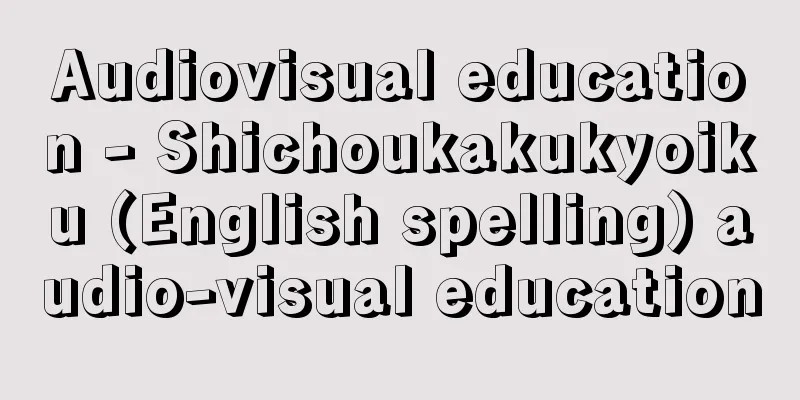Audiovisual education - Shichoukakukyoiku (English spelling) audio-visual education

|
In the narrow sense, it is an area of education that explores and puts into practice the appropriate combination of language and non-language teaching materials and the appropriate combination of teaching aids to present them in the teaching and learning process. Audiovisual education is a term that was introduced to Japan from the United States after World War II as a translation of audio-visual education. It was a way of thinking that rejected relying solely on language as a means of instruction (verbalism) and pursued the educational possibilities of images, and guaranteed a rich backing of concrete experience by introducing the results of science and technology into education, thereby effectively cultivating and teaching knowledge and emotion. On the other hand, audiovisual education in the broad sense is a branch of educational theory and practice that is concerned with the construction and use of various messages that control the learning process. That is, it can be said to be (1) the study of the characteristics and relative advantages and disadvantages of visual and non-visual messages used in the learning process for any purpose, and (2) the structuring and organization of combined human and machine messages in an educational context according to the expected flow of the messages in the context of the educational context. In other words, audiovisual education in the broad sense is "concerned with the design, production, selection, management, and use of the individual elements of the instructional system and the entire instructional system" (defined by DAVI, the predecessor of the Association for Educational Communications and Technology (AECT), 1945). [Shinohara Fuyoji] Historical backgroundThe term and theoretical structure of "audiovisual education" first appeared in the United States in the 1930s. It began in the wake of World War II, when American industry and the Army, Navy, and Air Force made use of and focused on developing slides, films, and records (later audiotapes) with the goal of effectively presenting non-verbal teaching materials in order to increase the efficiency of mass military production and military training in a short period of time. Later, when researchers and experts in this field returned to universities at the end of the war, these new devices made it possible to turn things that had previously been unthinkable into teaching materials. In particular, the use of film in education is called "visual education," and it can be said that it marked the direct beginning of the establishment of audiovisual education. Later, when talkies and television were introduced as new teaching tools, audiovisual education was no longer limited to an effective method of presenting audiovisual teaching materials, i.e., non-verbal teaching materials. In other words, American educationalist Edgar Dale (1900-1986) believed that non-verbal teaching materials should be used to enhance the effectiveness of verbal education. He proposed the idea of the "Cone of Experience," which classifies educational and learning experiences, based on the idea of "rich learning experiences," and stated that "each abstract expression must be combined," which includes both verbal and non-verbal teaching materials (Audio-Visual Methods in Teaching, 1946). Audiovisual teaching materials are diverse, ranging from direct and objective experiences, simulated experiences, tours, exhibitions, media such as television and radio, to visual and verbal symbols. These are closely related to the developmental stages of human concept formation. Incidentally, Orbis pictus , an illustrated textbook written by Comenius in 1658, was the forerunner of today's audiovisual teaching materials, and its significance has been highly praised since its time. The idea of intuitive teaching, which was passed down through Comenius, Rousseau and others and was systematized by Pestalozzi, was the main principle of educational reform in the 19th century, and has been carried on in today's audiovisual education ideas in the form of emphasis on observational activities such as tours, demonstrations and exhibitions, and on students' direct and purposeful activities. [Shinohara Fuyoji] From audiovisual education to educational technologyDue to the high economic growth in the 1960s, the rapid progress of electronics since the 1970s, and the remarkable development of the electronics and communications industries since the 1980s, the equipment used in the Japanese education world has advanced and developed significantly. However, the development of software (programs) to be operated and processed by teachers and instructors is still insufficient, and furthermore, research into the theory and practice of how to apply software in real educational situations is incomplete. Similar criticism has been made not only about overhead projectors (OHPs) and VTRs, but also about CAI and CMI, which were developed with the spread of microcomputers that appeared in 1978 (Showa 53). Even today, research into the development of software and the theory and practice of how to apply it, as well as the nature of media literacy or media education, are major issues in e-learning using electronic media, multimedia, which is considered to be the main media of the 21st century, web learning using the Internet, and WBT (Web Based Training), which is aimed at the establishment of knowledge and skills within companies. It is expected that teachers, researchers, engineers and others will deepen rational, scientific and comprehensive research into the theory, methods and content of audiovisual education, and develop the results into educational technology research that contributes to scientific educational reform and educational improvement. [Shinohara Fuyoji] "New Developments in Educational Technology," edited by the Educational Technology Research Results Publication Committee (1977, Daiichi Hoki Publishing)" ▽ "The Complete Works of Education, Volume 30: The Process of Teaching," by Nishinosono Haruo (1981, Daiichi Hoki Publishing)" ▽ "Educational Technology," edited by Nakano Terumi (1982, Gakken) " ▽ "Dale's Audio-Visual Education, by Edgar Dale, translated by Nishimoto Mijuji (1985, Japan Broadcasting Education Association)" ▽ "Media Theory: Aspects of Human Expansion, by Marshall McLuhan, translated by Kurihara Yutaka and Kawamoto Chusei (1987, Misuzu Shobo)" ▽ "Media and Education, revised edition, by Shiratori Motoo and Takakuwa Yasuo (1999, The University of the Air Foundation)" ▽ "Media Literacy: From the World's Frontlines," by Sugaya Akiko (Iwanami Shinsho)" ▽ "E. Dale Audio-Visual Methods in Teaching, 3rd ed. (1969, Dryden Press, New York) [References] | | | | | | | | |Source: Shogakukan Encyclopedia Nipponica About Encyclopedia Nipponica Information | Legend |
|
狭義には、教授・学習過程において、言語教材と非言語教材の適切な組合せとそれらを提示する教具の適切な組合せを探究し、実践していく教育領域。視聴覚教育は、audio-visual educationの訳語として、第二次世界大戦後アメリカから日本に導入された用語である。そこには、教授の手段を言語だけに頼ること(言語偏重主義verbalism)を排して映像による教育可能性を追求し、科学および技術の成果を教育へ導入することによって具体的経験の豊かな裏づけを保証し、知識や情意を効果的にはぐくみ教えようとする考え方があった。 一方、広義の視聴覚教育とは、教育の理論と実践の一分野であって、学習過程を制御する各種メッセージの構成と活用に関与するものである。すなわち、(1)いかなる目的にせよ、学習過程において使用される画像的および表情や心の動きなどで伝えられる非表示的メッセージの、それぞれの特質および相対的長所と短所とを研究すること、(2)教育場面における人間と機械との組み合わせによるメッセージを教育場面で予想される流れに沿って構造化し、組織化することである、ということができる。いいかえれば、広義の視聴覚教育とは、「授業システムにおける個々の要素および授業システムの全体について、その設計、製作、選択、管理、および利用に関することである」(現在のアメリカ教育工学会Association for Educational Communications and Technology=AECTの前身DAVI「アメリカ視聴覚教育部」による定義、1945)ということができよう。 [篠原文陽児] 歴史的背景「視聴覚教育」という用語や理論構成が現れたのは、1930年代以降のアメリカにおいてである。すなわち、第二次世界大戦を契機に、短期間に大量の軍需生産と軍事訓練の能率をあげるため、アメリカの産業界、陸海空軍が、非言語的教材を効果的に提示することを目標に、スライド、映画、レコード(のちに録音テープ)を活用し、またその開発に力を注いだことに始まる。その後、この分野の研究者や専門家が戦争の終結と同時に大学に戻ったとき、これらの新しい機器は、それまでは考えられなかったものの教材化を可能にした。 とくに映画の教育への利用は、「視覚教育」visual educationとよばれ、視聴覚教育成立の直接的な端緒を開いたといえる。その後トーキー映画やテレビジョンが新たな教具として導入されるに及び、視聴覚的教育は単に視聴覚教材、すなわち非言語的教材の効果的提示方法にとどまるものではなくなった。すなわち、アメリカの教育学者エドガー・デールEdgar Dale(1900―1986)は、言葉による教育効果をより高めるために非言語教材が利用されるべきであると考えた。そこで、言語教材と非言語教材の双方を含む「おのおのの抽象的表現は結合されなければならない」(Audio-Visual Methods in Teaching, 1946)とし、「豊かな学習経験」という考えを基盤として、教育・学習経験を分類した「経験の円錐(えんすい)」Cone of experienceの考え方を提唱した。視聴覚教材とよばれるものは、直接的・目的的経験、模擬経験、見学、展示、テレビ・ラジオなどのメディア、視覚・言語シンボルに至るまで多岐にわたっている。これらは、人間の概念形成に関する発達段階と密接な関係がある。 なお、1658年にコメニウスによって著された絵入り教科書『世界図絵』Orbis pictusは、今日の視聴覚教材の先駆であり、当時からその意義は高く評価されていた。コメニウス、ルソーらを経てペスタロッチによって体系化された直観教授の思潮は、19世紀における教育改革の主要な原則であったが、見学、演示、展示などの観察活動や生徒の直接的・目的的活動の重視という形で、今日の視聴覚教育の思潮のなかに受け継がれている。 [篠原文陽児] 視聴覚教育から教育工学へ1960年代の高度経済成長、1970年代以降のエレクトロニクスの長足な進歩、そして1980年代以降の電子および通信産業の目覚ましい発展などによって、日本の教育界で活用される機器は著しく進歩し、開発されてきた。ところが、教師や指導者によって操作され、処理されるべきソフトウェア(プログラム)の開発は、今日においてもいまだ十分であるとはいえず、さらに、いかに現実の教育の場面でソフトウェアを適用するかという理論および実践についての研究も不徹底であるといえる。オーバーヘッド・プロジェクター(OHP)、VTRをはじめとするこれまでの教育機器についてはもちろんのこと、1978年(昭和53)に出現したマイクロコンピュータの普及によるCAIおよびCMIについても同様の指摘がなされた。今日でも、電子メディアを使ったeラーニング、そして21世紀の主要なメディアと考えられているマルチメディアや、インターネットを活用したWebラーニング、あるいはとくに企業内での知識・技能の定着を目的としたWBT(Web Based Training)においても、メディアリテラシーあるいはメディア教育のありようとともに、ソフトウェアの開発とそれをいかに適用するかという理論と実践についての研究は大きな課題である。教師、研究者、技術者などが、視聴覚教育の理論、方法、内容について合理的、科学的、総合的探究を深め、その成果を科学的な教育改革と、教育改善に寄与する教育工学的研究にまで高めていくことが期待される。 [篠原文陽児] 『教育工学研究成果刊行委員会編『教育工学の新しい展開』(1977・第一法規出版)』▽『西之園晴夫著『教育学大全集30 授業の過程』(1981・第一法規出版)』▽『中野照海編『教育工学』(1982・学習研究社)』▽『エドガー・デール著、西本三十二訳『デールの視聴覚教育』(1985・日本放送教育協会)』▽『マーシャル・マクルーハン著、栗原裕・河本仲聖訳『メディア論――人間の拡張の諸相』(1987・みすず書房)』▽『白鳥元雄・高桑康雄著『メディアと教育』新訂版(1999・放送大学教育振興会)』▽『菅谷明子著『メディア・リテラシー――世界の現場から』(岩波新書)』▽『E. DaleAudio-Visual Methods in Teaching, 3rd ed. (1969, Dryden Press, New York)』 [参照項目] | | | | | | | | |出典 小学館 日本大百科全書(ニッポニカ)日本大百科全書(ニッポニカ)について 情報 | 凡例 |
Recommend
Beggar - beggar
〘Noun〙 (A variation of "katai (beggar)")...
Erk, LC (English spelling) ErkLC
...First of all, research into the lyrics and mel...
Rostov‐na‐Donu (English spelling)
The capital of the eponymous region in southwester...
Zamenhof - Lazaro Ludoviko Zamenhof
The creator of the international auxiliary langua...
Asyut (English spelling)
The capital of Asyut Governorate in Middle Egypt. ...
Oceania - Oceania (English spelling)
It is also called Oceania. The name "Oceania...
Kammerspiele - Kammerspiele
...As a result, it became possible to think of cr...
Church of Scotland
The Church of Presbyterianism in Scotland. Accordi...
Dai Nam Quoc Su Dien Ca (Dai Nankokushi Enka)
This is a poem in the Vietnamese national language...
Tile ware - Gaki
This type of earthenware has a tile-like texture ...
Nagayo Sensai - Nagayo Sensai
Year of death: September 8, 1902 (Meiji 35) Year o...
blue Japanese oak
…In Japan, oak is often translated as kashi, but ...
Haithabu
…A Viking trading centre located in the southern ...
Bernardino Ramazzini
1633‐1714 Italian physician. Born in Carpi in the ...
Kingdom of Italy (Regno d'Italia)
It is difficult to know when the idea of Italy a...









